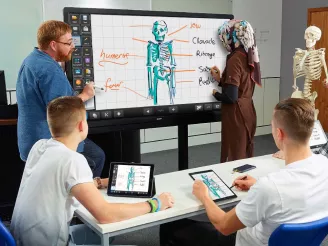Interactive Whiteboards
What are interactive whiteboards?
Typically used in schools and business meetings, traditional whiteboards have been the smart tech, dry-wipe solution for presentations and pitching, used with projectors to deliver content.
While they are still in use in some settings, more and more people are moving away from the bulkiness of the traditional projector and whiteboard set up, favouring more intelligent interactive display units.
Whiteboards have tried to keep up, and with the development of touchscreen interactive whiteboards and more innovative solutions, the life of the projector has extended. Still, in recent years, with handheld, interactive display solutions allowing global communication and real-time collaboration in offices and classrooms worldwide, a shift away from the whiteboards is inevitable.

Whiteboards vs Interactive display
Interactive whiteboards can cause everyday inconvenience for users;
- Clarity - Image quality is subject to light, contrast, cleanliness, and reflection issues - ever had to sit in a darkened room to study or work so you can see the screen, which looks washed-out or is unclear at best?
- Cleaning - They require near-constant cleaning, and with fairly substantial mechanical parts open to dust and wear and tear, the kit can break down more quickly than an interactive display screen.
- Cost - It may seem cheaper on the face of it, but replacing bulbs and expensive parts in a traditional projector whiteboard, gathers running costs that outweigh the quality of the output. When a bulb is £250+ a time, the price can accumulate.
- Usability - While reasonably simple to use, interactive whiteboard pens require regular calibration by the user - teachers cite this as a particular issue of use that can hold up the class when it goes awry. Then there are the shadows blocking the view when a user is standing in front of the projector. While smarter than a basic dry-wipe, smart interactive whiteboards are still clunky and somewhat basic.
While technology is always at the mercy of some level of breakdown, eliminating unnecessary processes for the user experience is vital.

Advantages of Interactive display screens
By contrast, Interactive display screens;
- Are easy to clean - no mechanical parts are exposed; simply keep the screen free of smears and dry.
- Use LED technology - with no lamps to replace, you can keep costs down, and brightness doesn’t diminish. With 50,000 hours of life in LED digital signage displays vs the costly light bulb, the advantages are clear.
- Enhance visibility - clarity and focus are drastically improved, with 178-degree viewing angles meaning viewers can see the screen, no matter where they are in the room. Combine this with LED technology, and there is no need to shut the blinds and work in the dark as you do with most interactive whiteboard solutions.
- Are engaging and fun - students and viewers are far more engaged when the room is light, visibility is clear, and they can collaborate over a presentation or in a meeting in real-time. By encouraging involvement through technology - and using advanced AV equipment with user experience specific AV software and accessories and education tools - learning is undoubtedly more enjoyable and productive, keeping your intended audience focused for longer.

Explore our range of AV Equipment
Choose from the options below


